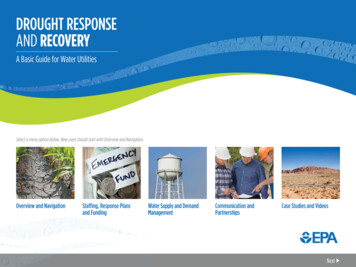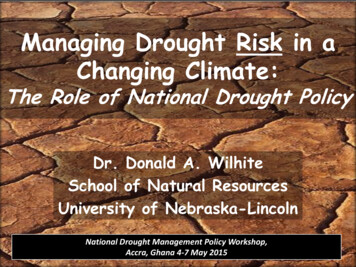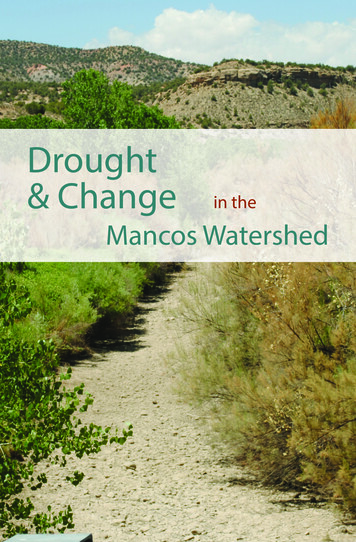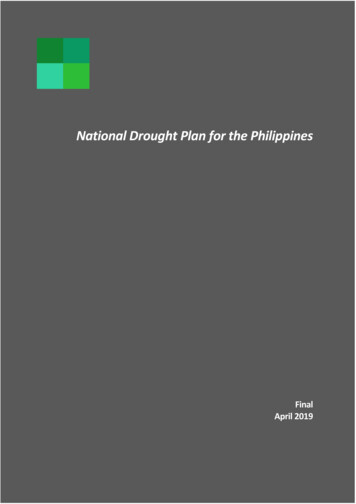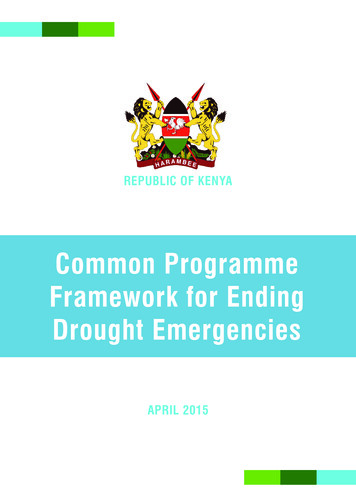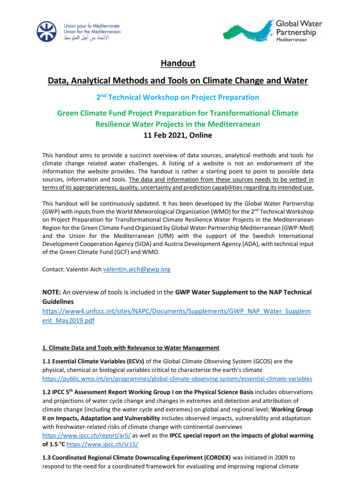
Transcription
Drought Conditions and Management Strategies in BotswanaDr. M. Manthe-TsuanengActing Deputy Permanent Secretary- Natural ResourcesMinistry of Environment, Wildlife and TourismPrivate Bag BO 199Gaborone, Botswanammanthe-tsuaneng@gov.bw25 July 20141
Drought Conditions and Management Strategies in BotswanaBackground:Botswana lies between the latitudes of 18 to 27 degrees South and the longitudes of 20 to29 degrees East, in the centre of the Southern Africa Plateau at a mean altitude of 1,000 mabove sea level. The country has a total land area of 582,000 square kilometres. The climateof Botswana is dry and semi-arid. The northern part of the country lies within the tropics,but because of the altitude and distance from the oceans, the climate is more temperate thantropical. Rainfall is low, erratic and unevenly distributed ranging from 600 mm in the northto less than 250 mm over the southwest (Figure 1).Figure 1: Spatial annual rainfall distribution over Botswana 1971-2000. Source: Department ofMeteorological Services, Botswana.The country experiences several natural hazards, of which drought is very common andrecurrent. The worst drought in recent years was from 1981 to 1987 followed by 1990 to1995. Droughts were also experienced in 1998/99 season, 2002 to 2006 and from 2011 to2013.The impacts of drought are wide ranging affecting almost all sectors of developmentespecially agriculture, water and health. Loss of income either due to loss of crops,livestock or employment in these sectors causes great stress on people’s livelihoods. Forexample, Figure 2 shows the decline in national cattle herd size since 2008 mainly due todrought.2
Figure 2: Botswana national cattle herd size from 2008 to 2013. Source: Botswana Vulnerability AssesmentReport 2013.Drought adversely affects the already fragile food and agricultural situation and seriouslyimpairs the rural economy and socio-cultural structures. About 70% of the rural householdsderive part of their livelihoods from agriculture; and crop production is mainly based onrain-fed farming. Rangeland resources, which cover more than 60% of the country and arethe basis for the cattle industry, are the most affected by drought albeit to varying degrees.Urban communities are mostly affected by lack of water as water supply becomes limitedto support daily activities including rationing of drinking water. The elderly, the destitute,children under the age of five are some layers of the population that are severely affectedby drought. Malnutrition amongst these groups is usually aggravated during times ofdrought.Drought Monitoring and Early Warning Systems:Botswana has an organized drought monitoring system. There is a strong network ofstakeholders and organizations dealing with drought monitoring and mitigation that includeNational Early Warning Technical Committee, Inter-Ministerial Drought Committee andRural Development Council. Institutions that monitor drought comprise of Ministry ofAgriculture; Ministry of Health; Ministry of Local Government and Rural Development;Ministry of Environment, Wildlife and Tourism; and Ministry of Minerals, Energy andWater Resources. The indicators used are rainfall, area ploughed and planted to reflect foodsecurity at household level; conditions of rangeland, livestock (Tables 1 and 2), water andwildlife; and malnutrition levels. The above institutions hold early warning monthlymeetings to track trends of the indicators.Table 1: Cumulative Livestock Mortality - 2007Animal Production Districts Cattle Goats Sheep Horses DonkeysKgalagadi North278980810Kgalagadi 0001614Molepolole6701515001153
Nata810000Serowe120009Southern (Kanye)210000Southern (Lobatse)4831201Southern (Jwaneng)TutumeTotal1681482003570077102910158IMDC 2008 ReportTable 2: Estimated crop area ploughed/ planted, 2007/2008 crop season (000 ha) communal sectorAgricultural Estimated of AreaEstimated of Area Estimatedof EstimatedofRegionPlanted 2004/05Planted 2005/06AreaArea(000 ha)(000 ha)Planted 2006/07 Planted 2007/08(000 ha)(000 ncistown 768.705IMDC 2008 ReportA Drought and Household Food Security Outlook tour is undertaken annually after therainy season (April-May). This exercise is conducted to complement early-warning reportscompiled on a routine basis by the various Government Departments and Ministries. Theassessment verifies and reconciles existing information at the national level with districtinformation, and also provides a forum to generate discussions with the districts on issuesof drought and drought management. Therefore the objectives of the exercise are twofold:(i)Ascertain whether or not it is a drought year. Drought in this context refers to adeficiency in rainfall in terms of its timing, spatial-temporal distribution, and/or overallamounts received and whether they were severe enough to negatively affect plant growth,water supplies, wildlife condition and ultimately human livelihoods and food security ingeneral; and,(ii)Determine the need or otherwise for government intervention, including themodification of form, magnitude, and scope of such interventions, particularly taking intoaccount the identified manifestations of the prevailing situation.Meteorological and Hydrological institutions form part of the Drought Assessment Teamand partake in the annual tour. Located at the Botswana Meteorological Services is theMonitoring for Environment and Security in Africa (MESA) programme for southern4
Africa which provides a drought service. It is an Earth observation System which relies onthe MESA Drought Monitoring Software and can provide a wide range of droughtinformation products including 10-day drought maps and monthly drought risk maps foruse by countries in the region.Vulnerability assessment:One of the Drought and Household Food Security Outlook tour team’s assignment relatesto assessing the current levels of human vulnerability and signs of stress and the possibleeffects of their interaction with the observed impacts of drought. To address this, thenutritional status of the under-five year olds’ is reviewed using the information generatedby the nutritional surveillance system. The situation with regard to destitution and socialwelfare issues is also reviewed so as to detect the current and emerging trends in thenumber and distribution of destitute persons. The extent of wildfires is also reviewed sincehigh fire damages may exacerbate levels of vulnerability if left unchecked.A review of the implementation of the feeding and intensive labour works (Ipelegeng)programme is also done. Based on conclusions arising from the above, the assessment teamdetermines the need or otherwise for continuation of Government intervention, includingthe form, nature and scope of the interventions.Botswana Vulnerability Assessment Committee (BVAC) was formed in 2008 as part of theregional effort to respond to the food security crisis that faced SADC countries at the time.Since then, the BVAC has been undertaking annual livelihood vulnerability assessmentswith the intention to inform decision making for interventions.Some of the most vulnerable sectors of the economy during drought years are theagriculture and the water sectors. Rural communities are highly depended on crop andlivestock production whilst shortage of water is a major problem in urban areas. Waterrationing is the norm during times of drought. The most vulnerable groups of societyinclude small scale farmers, the destitute, women especially in rural areas, children underthe age of five and the elderly, pregnant and lactating women, orphans and people affectedby HIV/AIDS.Communities with agro-based livelihoods suffer income losses and asset depletion,especially noting drought related livestock mortality. Drought impact and threaten thenutritional status of the population especially young children, which is anchored on thecountrywide feeding programme of the under-fives and vulnerable groups. Poor yieldharvests, shortage of seeds, and impaired purchasing power at the household levels aresome of the impacts of drought in Botswana.Emergency relief and drought response:The National Disaster Management Office (NDMO) under the Office of the President isresponsible for coordinating disaster risk management activities in Botswana. Drought5
however, is managed under the Ministry of Local Government and Rural Developmentthrough the implementation of the 1992 Drought Policy which gives priority to labourintensive public works to provide temporary employment as it aims to link relief anddevelopment (Buchanan-Smith and Tlogelang, 1994).During drought periods all ministries and local authorities are mobilized to assist in reliefprogrammes including public works projects designed to create employment duringdifficult times. The primary aim of the drought packages is to provide relief to humansuffering and prevent loss of life.The types and forms of emergency provided by government during times of droughtinclude increasing the employment quota for intensive labour works (Ipelegeng), purchaseof additional water bowsers to help augment human water supply shortages (emergencywater supply), free supplementary feeding of vulnerable groups in schools and directfeeding for all children under the age of five years who attend child welfare clinics andother vulnerable groups.Provision of drought relief subsidies on selected livestock feeds, vaccines andsupplements, cattle purchase schemes and monitoring of food supplies with the view ofimporting more if the need be are some additional measures undertaken.Practices to alleviate drought impacts:In line with major agricultural policy changes in the world economy of the green agendaand the reduction of farm policy programmes, the government in 1992 reviewed theDrought Relief Programme. Past relief measures that contributed to land degradation suchas clearance and de-stumping schemes were dropped. Support was given to proposals thatgave priority to investments in water conservation, appropriate land use and improvedmanagement techniques. The introduction of the National Water Master Plan, NationalConservation Strategy and Agricultural Policy contributed implementation of this approachIn order to address the drought situation, in the short term water restrictions and rationinghas been introduced. In the medium term, Government has put funds aside for theimplementation of drought mitigation projects. These include projects to upgrade andrefurbish boreholes, build treatment plants and upgrade water treatment schemes.To alleviate the impacts of drought related mortalities, farmers are encouraged to sell someof their livestock and to buy animal feed for the remaining. Cattle farmers are alsoencouraged to link up with arable farmers to use failed crop as fodder for livestock, Alsothe Livestock Advisory Centres are stocked with feed which is sold to farmers at asubsidised price during drought. Government has put in place measures to provide treatedwaste water from sewage ponds around the country for irrigation of horticultural crops.The need for knowledge and skills on drought management:Although Government has put in place strategies to mitigate the impacts of drought, there isneed to create awareness among the citizenry on the cyclic nature of drought as years of6
good rainfall are usually followed by those of drought conditions as such people shouldadopt coping strategies. Research institutions should develop drought forecasting modelsand enhance early warning systems to minimize negative impacts of drought to vulnerablegroups. Consequently, there is need to increase targeted training and developmentprogrammes towards areas of scarcity and comparative advantage.ReferencesBuchanan-Smith M and Tlogelang L, 1994. Linking relief and development: a case study ofBotswana. IDS Bulletin Vol.25 No3 1994, pp 1-6Cogill B. (1990) Vol.4 Information systems and the drought relief programmeGovernment of Botswana (2013). Botswana Drought and Household Food Security Report2012-2013.Government of Botswana (2013). Botswana Vulnerability Assessment Report 2013.Moepeng P, Drought management in Botswana. p 6-10. In: Regional Disaster ManagementSeminar, 26July-13 August 1999, Gaborone, BotswanaIMDC 2007. Drought and Household Food Security Outlook for the year 2007; Findingsand recommendations from the first Drought assessment tour 2007: 15January to 2 February 2007. Ministry of Development Planning; Division ofEconomic and Financial Policy. Inter- Ministerial Drought Committee(IMDC); Early Warning Technical Committee (EWTC) February 2007.IMDC 2008. Drought and Household Food Security Outlook for the year 2008; Findingsand recommendations from the first Drought assessment tour 2008: 14January to 2 February 2008. Ministry of Development Planning; Division ofEconomic and Financial Policy. Inter- Ministerial Drought Committee(IMDC); Early Warning Technical Committee (EWTC) February 2008.7
and enhance early warning systems to minimize negative impacts of drought to vulnerable groups. Consequently, there is need to increase targeted training and development programmes towards areas of scarcity and comparative advantage. References Buchanan-Smith M and Tlogelang L, 1994. Linking relief and development: a case study of Botswana.
